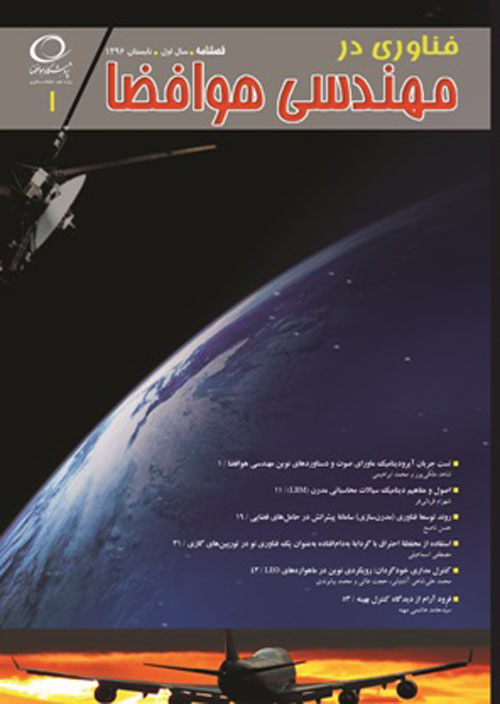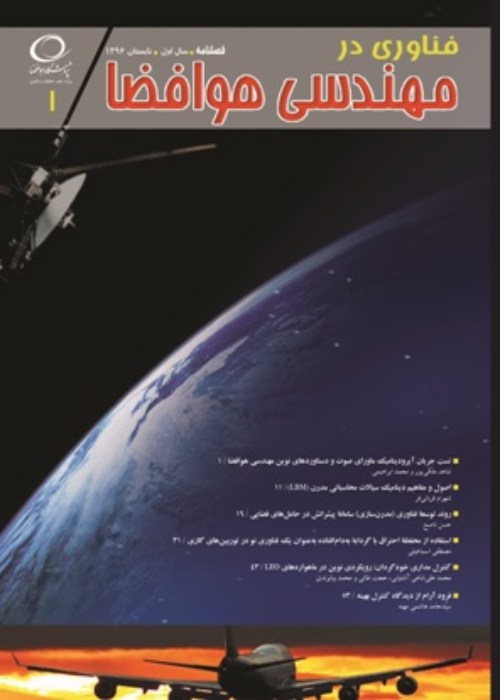فهرست مطالب

نشریه فناوری در مهندسی هوافضا
سال چهارم شماره 2 (پیاپی 13، تابستان 1399)
- تاریخ انتشار: 1399/08/18
- تعداد عناوین: 6
-
-
صفحات 1-10
در این مقاله، با در نظر گرفتن دینامیک عملگر به طراحی قانون هدایت در یک مسئله هدایت دو بعدی پرداخته شده است. برای دستیابی به این هدف، با استفاده از رویکرد گام به عقب، روش هدایت تناسبی به گونه ای تغییر داده شده تا پایداری سیستم حلقه بسته با وجود دینامیک عملگر تضمین شود. از این رو، سعی بر آن است که عملکرد حلقه هدایت (برای مثال مشخصات پاسخ گذرا و فاصله از دست دهی) با الگوریتم هدایت پیشنهادی در مقایسه با قانون هدایت تناسبی تا حد امکان بهبود داده شود. برای این منظور، با به کارگیری ایده گام به عقب و نظریه پایداری لیاپانف، قانون هدایت کلاسیک به گونه ای اصلاح خواهد شد تا حلقه هدایت در حضور دینامیک عملگر پایدار مجانبی شود. الگوریتم هدایت پیشنهادی در یک مسئله هدایت نوعی شبیه سازی می شود. نتایج به دست آمده کارآیی الگوریتم هدایت اصلاح شده را در مقایسه با قانون هدایت تناسبی نشان می دهد.
کلیدواژگان: هدایت تناسبی، فاصله از دست دهی، دینامیک عملگر، ایده گام به عقب -
صفحات 11-26
روش بهینه سازی دوسطحی زمانی مطرح می شود که مسئله هدف دارای دو تصمیم گیرنده با سلسله مراتب مختلف باشد. در چنین مسایلی، روابط بهینه سازی سطح زیرین در محدوده قیود سطح بالاتر موثر هستند و تفکیک آنها از همدیگر امکان پذیر نیست. مسایل بهینه سازی دوسطحی گستردگی و کاربرد زیادی در موضوعات مرتبط با حمل و نقل کالا و مسافر و در کل مسایل تصمیم گیری خرد و کلان دارند. در این مقاله آخرین یافته های تحقیقاتی و روش های مدلسازی و حل چنین مسایلی با تمرکز بر سه دهه اخیر ارایه شده است. علاوه بر آن جدیدترین کاربرد این نوع بهینه سازی در مسایل حمل و نقل های هوافضایی ارایه می گردد. در این مقاله، همچنین به معرفی الگوریتم های متداول کلاسیک و ترکیبی برای حل اینگونه مسایل می پردازیم.
کلیدواژگان: برنامه ریزی دوسطحی، الگوریتم کلاسیک، الگوریتم تکاملی، بهینه سازی دوسطحی، حمل و نقل -
صفحات 27-34
در این مقاله میدان جریان اطراف یک استوانه مستطیلی دوبعدی به صورت عددی شبیه سازی و اثرات مکش جریان در ناحیه حباب جدایش بررسی شده است. هدف برآورد میزان تاثیر مکش بر ابعاد حباب جدایش است. میدان جریان به صورت دو بعدی، تراکم ناپذیر، مغشوش و پایا تحلیل شده است. برای شبکه بندی میدان حل از نرم افزار گمبیت و برای تحلیل عددی از نرم افزار فلوینت استفاده شده است. مسئله در دو حالت بدون مکش و با وجود مکش تحلیل شده و تاثیر مکش بر ابعاد حباب جدایش مورد بررسی قرار گرفته است. مطابق نتایج حاصل شده می توان گفت وجود مکش طول حباب جدایش را کوچکتر می کند، به طوری که در چندین حالت مختلف این طول حدود 50 درصد کاهش می یابد.
کلیدواژگان: حباب جدایش، لایه مرزی، مکش جریان، استوانه مستطیلی، شبیه سازی عددی -
صفحات 35-44
این مقاله به بررسی آنتن های شفاف به عنوان راه حلی برای حل مشکلاتی مانند زیبایی، آیرودینامیک بودن آنتن در کاربردهای مختلف و نقش آن در کاربردهای فضایی می پردازد. در این مقاله، دو دسته کلی آنتن های شفاف بررسی شده است. در دسته اول، ساختار آنتن که در آنتن های متداول معمولا از فلزات ساخته می شود، با استفاده از تکنولوژی فیلم نازک و یا با مشبک نمودن قسمت های فلزی آنتن محقق می شود. دسته دوم، آنتن های تشدیدکننده دی الکتریک (DRA) شفاف است. آنتن های DRA متداول از جنس ماده ای غیررسانا ساخته می شود. بنابراین، با جایگزین کردن دی الکتریک های متداول با دی الکتریک های شفاف، مانند شیشه، می توان آنتن های DRA شفاف را محقق نمود. در انتها، به تبیین این نکته پرداخته خواهد شد که آنتن های شفاف می توانند در کاربردهای فضایی با ادغام با سایر ادوات، مانند سلول های خورشیدی به کاهش حجم و وزن ماهواره ها کمک کنند.
کلیدواژگان: آنتن های شفاف، فیلم نازک، سلول خورشیدی، ماهواره -
صفحات 45-64
سرعت بالای رشد بهره برداری از پهپادها، سرمایه گذاری های دولت ها برای توسعه زیرساخت های لازم برای گسترش این فناوری، تنوع کاربردها و مزایای حاصل از نتایج عملی استفاده از این فناوری در هر یک از کاربردها، بیانگر جایگاه ویژه این فناوری در آینده است. از سوی دیگر، ویژگی های ساختاری و حرکتی این وسایل پرنده موجب شده تا بهره برداری از آن ها با نگرانی های بسیاری در سطح دولتمردان برای حفاظت از دارایی ها و امنیت کشورها و در سطح عموم مردم برای حفظ حریم شخصی همراه باشد. در مقابل، فرصت هایی که توسعه پهپادها برای دولت ها در حوزه های مختلف، از جمله اشتغال زایی، کاهش هزینه ها، مدیریت سوانح و غیره فراهم می کند، موجب شده تا برنامه ریزی های بلندمدتی برای رفع موانع پیش روی توسعه پهپادها انجام شود. از این رو، در این مقاله تلاش می شود تا پس از بررسی فرصت ها و چالش های پیش روی توسعه این فناوری در ایران، روش های مطرح برای پاسخ به چالش مدیریت ترافیک پهپادها با جزییات بررسی شود.
کلیدواژگان: پهپاد غیرنظامی، کاربرد تجاری، چالش ها و فرصت ها، مدیریت ترافیک پهپاد -
صفحات 65-80
امروزه تمام ارگان ها و سازمان های هوانوردی جهان از جمله ایکایو به دنبال راه حل هایی جهت رفع بحران کمبود فضای پروازی، رشد ترافیک هوایی جهانی و فراهم کردن ایمنی پروازها هستند. نگرش کارایی محور در بحث ناوبری (PBN) که یک جهش از ناوبری مبتنی برسیستم به ناوبری مبتنی بر عملکرد است. این نگرش راه حلی است که می تواند مشکلات ناشی از افزایش تعداد پروازها و شلوغی مسیرهای هوایی را بهبود بخشد. طرح های پروازی PBN از طریق اجرای RNP و RNAV پیاده سازی می شود. برای استفاده از این طرح ها در گیرنده FMS هواپیماها چندین حسگر ورودی در نظر گرفته شده است. مهم ترین حسگر ورودی GNSS است. این سنسور، به صورت پیوسته از عملیات PBN پشتیبانی می کند. با این حال، سرویس های GNSS در برابر اثرات جوی و نویزهای عمدی آسیب پذیر هستند. در این مقاله، فرصت ها و چالش های مربوط به استفاده از DME به عنوان منبع جایگزین برای موقعیت یابی، ناوبری و زمان بندی (PNT) در غیاب خدمات GNSS مورد بحث قرار می گیرد.
-
Pages 1-10
This paper concerns on guidance law design by considering of the actuator effect. For achieving this goal, the proportional guidance (PN) method would be modified via the back-stepping approach such that the closed-loop stability is guaranteed in the presence of the actuator dynamic. Thus, it is interested to improve the guidance system performance (for example the transient response characteristic and miss-distance error) by the proposed guidance algorithm. Hence, the PN guidance law would be corrected such that the closed-loop system is asymptotically stabilized. The suggested algorithm is numerically simulated in a typical guidance problem. The simulation results verify the effectiveness of the redesigned guidance technique in comparison with the PN method.
Keywords: Proportional navigation, Miss-distanceerror, Actuator dynamic, Back-stepping Approach -
Pages 11-26
Bilevel optimization is proposed when the objective problem has two decision makers with different hierarchies. In such cases, the lower level decision is embedded within the higher-level constraints. Micro and macro decision making of transportation are considered as hierarchal problems, On the one hand, user’s decision tends to choose lower cost, and the other hand is transportation company’s to maximize its benefit. This paper’s aim is to provide a review on research and methods with different concerns for modeling and solving bilevel problems in last three decades. In addition, the latest application of this kind of optimization is presented in aerospace transport issues. This paper also introduces the classic and heuristic algorithms for solving bilevel optimization.
Keywords: Bilevel programming, classical optimization, Evolutionary Optimization, bilevel optimization, Transportation -
Pages 27-34
In this paper, the flow field around a two-dimensional rectangular cylinder was numerically simulated and the effects of the flow suction on the separation bubble were investigated. The purpose was to estimate the effect of suction on the dimensions of the separation bubble. The flow field was assumed incompressible, turbulent, and two-dimensional. Gambit software was used for grid generation and FLUENT for numerical simulation.The problem was analyzed in two states: with and without suction, and the effect of suction on the separation bubble was investigated. According to the results, it can be said that the suction length of the separation bubble is smaller, so that in several different cases this length is reduced by about 50%.
Keywords: Separation bubble, Boundary Layer, flow suction, rectangular cylinder, numerical simulation -
Pages 35-44
This paper is focused on the application of transparent antennas to address the issues related to the unpleasant appearance and non-aerodynamic behavior of traditional antennas. Transparent antennas are divided in two main categories. In the first category, the resonant structure and the ground plane of an antenna, which is usually made of metal, is made of thin film transparent materials or a metallic mesh. In the second category, the structure of a dielectric resonator antenna (DRA), which is made opaque dielectrics, is realized, using a transparent dielectric, such as glass. In this paper, common types of transparent antennas and the methods of realizing each of these antennas are reviewed. The paper also discusses different potential applications of such antennas, especially space applications to save the limited available mass budget in small satellites.
Keywords: Transparent antennas, Thin film, Solar Cell, satellite -
Pages 45-64
Increasing the rate of drone's usage growth, improvement of infrastructure needed for drone's development by governmental investment, vast and diverse applications and good outcome of the technology depicts special situation for this technology in the future. Moreover, special structural characteristics of this aerial vehicle, cause concern in governments about infrastructure, assets protection, securities and in nations for privacy issues. Governments try to have long term strategical planning to remove obstacles before drones development to make profit from opportunities that drones provide in different area, such as job creation, decrease costs, management of natural disasters, etc.here, After surveying opportunities and challenges of drones development in Iran, solutions to UAV traffic management are reviewed in detail.
Keywords: Civil Drone, Commercial Application, challenges, opportunities, Drone Traffic Management -
Pages 65-80
Today, all world's aviation organizations, including ICAO, are looking for solutions to airspace shortage, growth of global air traffic, and safety of flights. Performance based navigation (PBN), which is a transition from System-Base to Performance-Base Navigation is a solution that can improve the problems caused by an increase in the number of flights and complexity of air routes. PBN flight plans are implemented through RNP and RNAV. To use these designs, FMS receivers have several input sensors. The most important GNSS input sensor continuously supports PBN operations. However, GNSS services are disable due to atmospheric effects and human-made noise. This paper discusses the opportunities and challenges associated with use of DME as an alternative source for positioning, navigation, and timing (PNT) in the absence of GNSS services.
Keywords: PBN, RNAV, FMS, DME, GNSS


